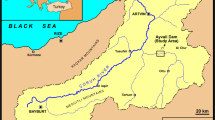Abstract
This paper discusses the engineering geological investigations, diversion tunnel support design and slope stability assessment studies carried out at the Sulakyurt dam site, northeast of Ankara, Turkey. The Sulakyurt dam will be used for flood flow control and water storage for irrigation. Engineering geological mapping, discontinuity surveys, core drilling, water absorption and laboratory tests were undertaken. The RMR, Q and GSI approaches were used to estimate the rock mass quality, site characteristics, rock mass parameters and appropriate tunnel support elements. The results of kinematic and limit equilibrium analyses for the slopes on the right and left banks are reported.
Résumé
L’article présente les travaux de reconnaissance géologique, la conception du soutènement de la galerie de dérivation et les études de stabilité des pentes réalisés sur le site du barrage de Sulakyurt, au nord-est d’Ankara, en Turquie. Le barrage de Sulakyurt permettra le contrôle des crues et l’irrigation des terres. Une carte de géologie de l’ingénieur, des études de discontinuités, des forages carottés, des tests de perméabilité et des essais de laboratoire ont été réalisés. Les méthodes RMR, Q et GSI ont été utilisées pour estimer la qualité du massif rocheux et les paramètres correspondants ainsi que pour définir les dispositifs de soutènement de la galerie de dérivation. Les résultats des analyses de stabilité des pentes sur les rives droite et gauche sont présentés.








Similar content being viewed by others
References
Barton N (2002) Some new Q-value correlations to assist in site characterization and tunnel design. Int J Rock Mech Min Sci 39(1):185–216
Barton NR, Lien R, Lunde J (1974) Engineering classification of rock masses for the design of tunnel support. Rock Mech 4:189–239
Basarir H (2006) Engineering geological studies and tunnel support design at Sulakyurt dam site, Turkey. Eng Geology 86:225–236
Bhasin R, Grimstad E (1996) The use of stress–strength relationships in the assessment of tunnel stability. Tunn Undergr Space Technol 11(1):93–98
Bieniawski ZT (1974) Geomechanics classification of rock masses and its application in tunneling. In: Proceedings of the third international congress on rock mechanics, International Society of Rock Mechanics, Denver 11A:27–32
Bieniawski ZT (1978) Determining rock mass deformability: experience from case histories. Int J Rock Mech Min Sci Geomech Abstr 15:237–247
Bieniawski ZT (1989) Engineering rock mass classifications. Wiley, New York, 251 p
Goel RK (1994) Correlations for predicting support pressures and closures in tunnels. Ph.D. Thesis, Nagpur University, Nagpur, India, 308 p
Goel RK, Jethwa JL, Paithankar AG (1995) Indian experiences with Q and RMR systems. Tunn Undergr Space Technol 10(1):97–109
Goodman RE (1989) Introduction to rock mechanics. Wiley, New York, 562 p
Grimstad E, Barton N (1993) Updating the Q-system for NMT. In: Proceedings of the international symposium on sprayed concrete, Fagernes, Norwegian Concrete Association, Norway, Oslo, 1993, 20 pp
Hoek E (2000) Practical rock engineering. Unpublished notes. http://www.rocscience.com
Hoek E, Bray J (1981) Rock slope engineering, 3rd ed. The Institution of Mining and Metallurgy, London, 358 p
Hoek E, Brown ET (1998) Practical estimates of rock mass strength. Int J Rock Mech Min Sci 34(8):1165–1186
Hoek E, Kaiser PK, Bawden WF (1995) Support of underground excavations in hard rock. Balkema, Rotterdam, 215 p
Hoek E, Marinos P, Benissi M (1998) Applicability of the geological strength index (GSI) classification for very weak and sheared rock masses. The case of the Athens Schist Formation. Bull Eng Geol Env 57:151–160
Hoek E, Carranza-Torres C, Corkum B (2002) Hoek–Brown failure criterion –2002 edn. In: Hammah R, Bawden W, Curran J, and Telesnicki M (eds) In: Proceedings of NARMS-TAC 2002, Mining Innovation and Technology. University of Toronto, Toronto, 10 July 2002, pp 267–273
ISRM (1981) Rock characterizition, testing and monitoring. In: Brown ET (ed) ISRM suggested methods. Pergamon Press, NewYork, pp 211
Marinos V, Marinos P, Hoek E (2005) The geological strength index: applications and limitations. Bull Eng Geol Environ 64:55–65
Öcal A (1994) Computer aided kinematic analysis for jointed rock slopes. M.Sc. Thesis, Middle East Technical University, Ankara
Ozsan A, Kadioglu YK (1997) Engineering geological properties of granotoids at Sulakyurt dam site (in Turkish). Geol Eng 51:30–35
Özsan A, Karpuz C (1997) Preliminary support design for weak rock, Sulakyurt diversion tunnel. In: The IMM tunneling conference, 2–4 September, London, 1–10
Read SAL, Richards LR, Perrin ND (1999) Applicability of the Hoek–Brown failure criterion to New Zealand greywacke rocks. In: Proceedings of the ninth international society for rock mechanics congress, Paris, 2, 655–660
Rocscience (2002a) Dips user’s guide. Rocscience Inc., Toronto, Ontario, Canada
Rocscience (2002b) RocLab user’s guide. Rocscience Inc., Toronto, Ontario, Canada
Serafim JL, Pereira JP (1983) Considerations of the geomechanics classification of Bieniawski. In: Proceedings of the international symposium on engineering geology and underground construction, vol 1. Balkema, Rotterdam, 1133–1142
Singh B, Viladkar MN, Samadhiya NK, Mehrota VK (1997) Rock mass strength parameters mobilized in tunnels. Tunn Undergr Space Technol 12(1):47–54
Trueman R (1998) An evaluation of strata support techniques in dual life gateroads. Ph.D. Thesis, University of Wales, Cardiff. In: Read SAL, Richards LR, Perrin ND (1999) Applicability of the Hoek–Brown failure criterion to New Zealand greywacke rocks. Proceedings of the ninth international society for rock mechanics congress, Paris, vol 2. 655–660
Acknowledgment
The authors wish to express their deep gratitude to the managers of the General Directorate of State Hydraulic Works for providing the necessary data. Special thanks go to Dr. Yusuf Kağan Kadıoğlu for his valuable help.
Author information
Authors and Affiliations
Corresponding author
Rights and permissions
About this article
Cite this article
Özsan, A., Öcal, A., Akın, M. et al. Engineering geological appraisal of the Sulakyurt dam site, Turkey. Bull Eng Geol Environ 66, 483–492 (2007). https://doi.org/10.1007/s10064-007-0092-3
Received:
Accepted:
Published:
Issue Date:
DOI: https://doi.org/10.1007/s10064-007-0092-3




